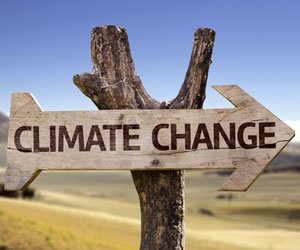Last Updated on June 26, 2022 by Laura Turner
Updated October 28, 2021. The article was updated to correct minor grammatical errors and formatting inconsistencies.
When most student doctors take a moment from their busy schedules to think about climate change, what probably comes to mind is rising ocean levels or melting polar ice caps. What many do not think about, even in the medical profession, is the effect that climate change potentially has on human health. As many of the foremost meteorological institutions predict that the climate is only destined to become warmer in the coming decades, these health effects will very likely affect doctors going into practice in the near future.
This article will take a look at several of the categories of health problems that are more vulnerable to climate change – and that could have a big impact on physicians now going into practice.
Respiratory Diseases
One of the areas in which doctors will likely feel the impact of climate change is that of respiratory diseases, particularly allergies and asthma. According to the National Institute of Environmental Health Sciences (NIEHS), this impact will happen for a number of reasons. Firstly, increases in ground-level ozone levels can trigger respiratory symptoms like inflammation of the lungs, causing a decrease in lung function and other symptoms like chest pains, coughing, and congestion. Increased temperatures and carbon dioxide will also increase levels of allergens such as pollen and mold spore counts, making it more difficult for sensitive people to cope.
The World Allergy Association released a statement earlier this year noting that the increased prevalence of allergic airway diseases–particularly asthma and allergic rhinitis–to what they term to be epidemic proportions has largely been brought about by a combination of increased air pollution and climate change, specifically citing many of the factors mentioned by the NIEHS: a higher concentration of carbon dioxide and other greenhouse gasses, decreased air quality and increased frequency and duration of heatwaves. The association published this position statement to underline “the importance of this health hazard and highlight the facts on climate-related health impacts, including deaths and acute morbidity due to heat waves and extreme meteorological events, increased frequency of acute cardiorespiratory events due to high concentrations of ground-level ozone, change in the frequency of respiratory diseases due to transboundary particulate pollution and altered spatial and temporal distribution of allergens and some vectors”.
In short, if climatic trends continue, it is likely that doctors will continue to see an upsurge in the number of patients who need to be treated directly for respiratory ailments like asthma or allergies or for conditions secondary to allergies, such as sinusitis or ear infections.
Vector-Borne and Zoonotic Diseases
Vector-borne and zoonotic diseases (VBZD) refer to infections whose transmission involves animal hosts or vectors, and this is another general category of disease which is predicted to worsen with a warming climate. The most common VBZD’s include malaria, avian flu, yellow fever, dengue, murine typhus, and West Nile virus, and while granted, many doctors will not work directly with patients with many of the tropical diseases, West Nile is certainly present within the United States, and the country is also vulnerable to the spread of some infections through foreign travelers or for American citizens returning from abroad.
The NIEHS notes that rising temperatures can lead to both the spread of vectors into areas that historically were too cold to colonize and also to an overall rise in the vector population. The expansion of vectors can also occur secondarily to the displacement of the human population due to drought, flooding, or other weather-related events.
One example of the possible exacerbation of a vector-borne disease due to climate change has been noted by South American researchers, who this year published an article on the vector Lutzomyia, which is responsible for cutaneous leishmaniasis. This condition is endemic to the Amazonian basin but computer models predict the spread of the vector which causes this disease to higher latitude and elevations as the climate warms–areas once too cold to support this form of life. The scientists note that, disturbingly, some of these are areas with a greater human population and density than where the vector currently resides, so the leishmaniosis has the potential to affect more people in the future than it did in the past.
The case of leishmaniosis is just one example of the potential for the spread of vector-borne diseases, which could present a challenge for doctors who will have to familiarize themselves with conditions they were not treating in the past as many species of concern shift and expand in response to global warming.
Waterborne Diseases
Waterborne diseases occur when microorganisms, bio-toxins, and manmade contaminants find their way into the water used for drinking, cooking, and other personal tasks. Diseases that fall into this category include cholera, schistosomiasis, and general gastrointestinal problems including nausea, vomiting, and diarrhea. Again, climate change is expected to exacerbate these diseases in a number of ways. The NIEHS notes that droughts related to rising global temperatures have the potential to concentrate effluent pathogens and overwhelm treatment plants, thus contaminating surface water. It is believed that changes in ocean and coastal habitats–including chemical changes such as salinity and acidity and an increase in contaminant runoff will lead to the degradation of freshwater supplies used for household and municipal purposes.
A research paper published in the journal Environmental Health this year noted that the effect that weather can have on waterborne infections and disease constitutes a major public health concern and to understand these trends, it analyzed 24 other separate studies which in one way or another dealt with the relationship between a rise in precipitation/temperature and the rise in rates of waterborne diseases. The majority of the studies did find a correlation between these two factors. However, the authors note that is it a complex public health issue with a multiplicity of factors coming into play, including the specific type of microorganism causing the disease/infection, the geographical area in which the problem occurs, and local resources for water management/treatment.
Be that as it may, if extreme events like flooding and hurricanes do become more frequent or severe, damage to infrastructure and compromise of potable water sources can well translate into an uptick in waterborne diseases which doctors both in the United States and abroad will have to contend with in their practice.
Weather-Related Morbidity and Mortality
The United States, like every other country in the world, has extreme weather events such as hurricanes, floods, blizzards, and droughts and will be affected equally by these conditions as the climate warms, leading to infrastructure damage and higher rates of weather-related morbidity and mortality. It is predicted that the rising temperatures will lead to an increasing frequency and severity of floods (which can lead to increased exposure to toxins from runoff as well as to waterborne diseases), hurricanes (which can also lead to infrastructure damage as well as death and injury), and heatwaves.
Authors writing in the journal Environmental Health Perspectives this year noted that extreme weather events already cause hundreds of deaths and injuries in the United States annually–and that due to the changing climate, these incidents are predicted to become both more frequent and more severe. Authors predict that the fallout from this will include an increase in such causes of mortality and morbidity as drownings, blunt force trauma, penetration, and other traumatic wounds and subsequent infections, electrocutions, and burns secondary to events like wildfires.
An uptick in injuries such as those listed above could well have an impact on physicians practicing in areas like emergency medicine, wound care, burn units, and intensive or critical care units and authors from the study note that these have the potential to put even greater stress on an already burdened healthcare system.
Cancer
This disease, marked by the abnormal proliferation of cells and the possible invasion of neighboring or remote tissues/organs, comes in over 100 different forms which, combined, represent the second leading cause of death in the United States; scientists believe that several characteristics of climate change will potentially cause a rise in cancer rates. Much of this increased risk is predicted to come from increased exposure to toxic chemicals following traumatic events like floods or hurricanes as well as a decrease in overall air quality (a risk factor for lung cancer) and increased exposure to UV radiation due to a thinning ozone layer (a risk factor for cancers of the skin and eyes).
A 2011 article appearing in the journal Photochemical and Photobiological Sciences entitled “The Human Health Effects of Ozone Depletion and Interactions with Climate Change” noted that the combination of climate change and changes in the ozone will likely result in increased levels of UV-B radiation on the Earth’s surface. This in turn can lead, despite the widespread use of protective clothing, sunscreen, and sunglasses, to a rise in cancers of the eye, including cancer of the retina, and to skin cancers such as basal and squamous cell carcinoma and melanomas. The researchers note that rates for all three of these cancers have risen in the past several decades and are predicted to continue this trend, thanks in part to global climatic changes.
These trends could well impact the clinical practice of not only general practitioners but also oncologists and ophthalmologists who may struggle to keep up with the rising tide of these kinds of illnesses as global weather continues upon its warming trend.
The takeaway here is that while the issue of climate change has been, at least in America, reduced to the level of another hot button political issue, it is also a matter of science–and what the science is predicting about the impact of future climatological changes will likely have an impact on the practices of many new and beginning doctors, particularly those the specialties like oncology or pulmonology or those interested in research or clinical practice with tropical diseases. Students studying medicine today would do well to be aware of these potential issues, as they could affect their future patients and practice.


